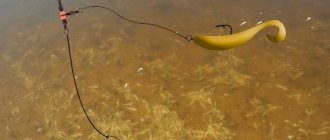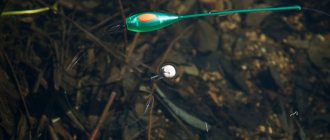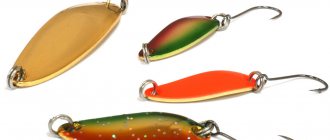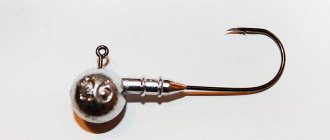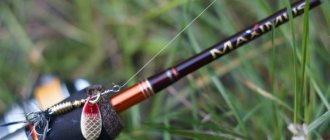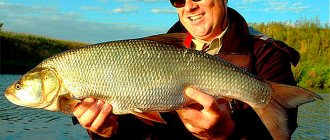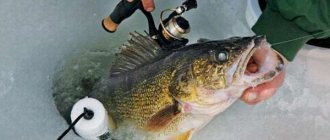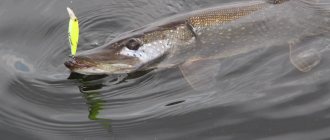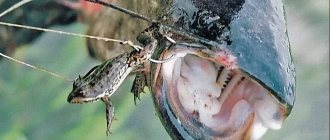These instructions for equipping a spinning rod are suitable for all types of spinning rods - jig, ultralight, microjig and jig. All elements are identical, you just need to choose the gear that suits your purposes. Using the example of a spinning rod shown below, you can catch pike, perch and pike perch.
In order to equip (put together all the elements of gear and equipment) a spinning rod for your first fishing trip you will need:
- spinning rod
- spinning reel
- braided fishing line
- swivel
- bait (for example, a spinner or wobbler).
How to equip a spinning rod for pike fishing
Knowledge of the basic and universal configuration of the gear, as well as some nuances regarding the specific direction of fishing for the toothy predator, will help you correctly assemble a spinning rod for pike. A novice fisherman needs to collect his first gear based on the conditions that provide the opportunity to fish with various types of bait. This equipment feature will help you gain initial skills in using both the specialized fishing rod itself and various styles of bait fishing.
As you gain experience, you will be able to delve deeper into the topic and assemble highly targeted gear for a particular bait and its animation style. At this stage, we will focus on the specific collection of spinning equipment for pike for beginners.
Buoyancy and leash
When installing a wobbler on a spinning rod, we take into account the change in buoyancy of the bait with a metal leash. On large minnows this is not critical - buoyancy remains almost unchanged. However, on small minnows and cranks, the suspender can turn into a sinking one, and a floating one into a slowly floating one.

To properly equip a spinning rod with a small wobbler, this needs to be thought through. The weight of the load can be adjusted using an interchangeable set of measures:
- Try leashes of different lengths and thicknesses, and therefore weights.
- Try removing or installing a winding ring, swivel or knotless hook on the other end of the twist.
- Change the tees to lighter ones, as well as the rings on them.
If all else fails, for example, the suspender begins to sink and this is unacceptable - we tie a piece of fluorocarbon to the cord with a carrot, and tie it to the wobbler with a rapala knot without any accessories - this is the lightest option in terms of weight. The only easier way is to directly tie the cord to the wobbler - but here there is a high probability of the pike cutting off the bait.
Author of the article: Kamyshanov Andrey.
Experienced amateur fisherman. Popularizer of amateur fishing and practices. With a fishing rod in hand from an early age. Founder and author of the fishing websites Podlednik.ru and Rybafan.ru, as well as the YouTube channel RYBAFAN
Selecting a spinning rod
A spinning rod for pike fishing must meet the requirement of low weight. After all, fishing of this type is characterized by a high level of dynamics, with constant re-casts and energetic work of the tackle during the retrieve.
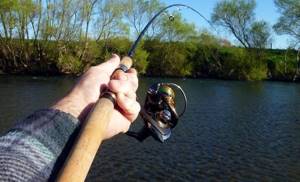
First you need to purchase a composite or carbon-fiber spinning rod of plug-in design. The length of gear for fishing from coastlines of 2.7 meters will be the optimal parameter. If you plan to fish from a boat, then a range of 2.1–2.5 meters will allow you to cast with the best comfort. The semi-fast action makes it possible to practice the skill of retrieves with most types of pike lures, and this characteristic of the form will make hooking the trophy much more reliable than a slower action tackle. A test level of 10–30 grams will cover the entire range of the most suitable simulators for any fishing conditions.
Rod
Fast action spinning rods are best suited for pike fishing . If you have to fish from a boat or covered with bushes and forests, you need to choose among rods with a length of 1.8-2.4 m . These spinning rods are easy to handle when fishing from a boat, and they also make it easy to get through thickets.
If you have to fish from an open shore , it is better to use spinning rods 2.4 or 2.7 , and in some cases 3 m long . This rod will allow you to make long casts, reaching promising points.
The greater the weight of the baits used, the depth and strength of the current test should be . For pike fishing use :
- spinning rods with a dough of about 5-15 g - used mainly for hunting small predators from the shore;
- spinning rods with a dough of about 7-28 g - the most universal, used for both coastal and boat fishing for pike;
- spinning rods, the upper limit of the test range of which exceeds 40 g , are used mainly for fishing on rivers and reservoirs from a boat.
Once a suitable rod has been selected, it needs to be equipped with a reel.
Coil selection
A spinning reel has long been considered a classic element of spinning equipment. An inexpensive and quickly mastered accessory is selected for the fishing rod, comparing its size and weight. The reel must have a friction brake that allows you to change the settings of the maximum force parameters and the volume of the spool that can accommodate one hundred meters of cord.
Important! When buying a mechanism, it is advisable to include a replaceable spool in its kit, which will give the novice fisherman the opportunity to practice his skills on different types of fishing line.
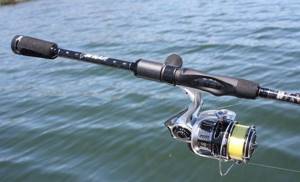
For pike fishing, a reel with a gear ratio of 1:5 is sufficient, and a spool size of 2000–3000 units is enough for optimal thicknesses of braided and monofilament cord in a hundred-meter volume. You should not rush to buy an expensive mechanism. You can also feel the work of the non-inertional system on a product in the mid-price range. The main thing is that the components of the transmission mechanism have a smooth motion, and that the material of the gears and shafts is made of metal alloys. Play in the handle and gaps in the body parts indicate poor quality assembly of the product, which is not worth purchasing.
Read more about choosing a reel for pike fishing.
Friction brake
Spinning pike fishing does not exclude the possibility of catching large specimens of predators, the presence of an adjustable friction brake in the mechanism will help cope with the resistance of which without breaking the tackle. The location of the function in the front part of the reel body makes it easier to adjust the force already in the process of playing the hooked fish, so it is recommended to initially pay attention to this nuance when purchasing. By holding the brake to the limit and applying force to the cord, the spool should stand dead in place. Gradually releasing the clutch and pulling the cord, the spool should slowly release the thread with the characteristic ringing sound of a ratchet.

How many bearings should there be in a reel?
The bearings of the mechanism make the inertia-free movement smooth and even without jerking or noticeable limp when turning the handle. But it’s not worth striving to stuff the inertia-free bearings with bearings. Firstly, this complicates the mechanism and requires high costs for its maintenance, and secondly, excess does not guarantee reliability, because these elements do not duplicate each other and the failure of one of them can negatively affect the operation of the entire product. To obtain stable skills, three bearings are sufficient, allowing the reel to smoothly transmit the movement of the handle to a set of toothed shafts and gears.
Which reel to choose for fishing beginners
Any fishing store offers a wide range of reels for spinning fishing. They are all divided into types such as: inertial, inertial-free, multiplier. Fishermen with extensive experience suggest paying attention to spinning reels to assemble a spinning rod . They do not advise beginners to use multiplier versions of this tackle , since they have a low sensitivity indicator and are not suitable for long casts.
Reels with the following parameters are suitable for spinning fishing for beginner anglers:
- Metal body instead of plastic;
- Medium size with a spool not exceeding 3.5 thousand;
- Smooth ride. If it squeaks, it is better to refuse the purchase. In the store you need to take the rod and check the smoothness of the action yourself;
- High-quality fastening of the bow and a minimum number of backlashes. This is an important indicator of the quality and reliability of the reel. This product will last for many years.
- The capacity of the reel must be at least 50 meters of fishing line. If it is less, you will have to give up fishing with long casts.
Also important is the place to make the purchase. This should be a trusted store with a good reputation that can guarantee the quality of the products offered to fishermen.
Which fishing line to choose
The choice of fishing line affects the sensitivity of the equipment . When deciding on the material of the cord, they focus on the fishing distance and the demands of the bait in terms of scrupulous control over the parameters of its game. Braided lines are much stiffer than monofilament lines. The controllability of the bait and transmission of the bite signal when using braided line is higher than when using monofilament fishing line. At the same time, monofilament fishing line allows for more comfortable fishing, compensating for overloads with a high stretch coefficient.
Important! Monofilament is recommended for fishing at short distances and when working with fishing tools that do not require active animation of the angler.
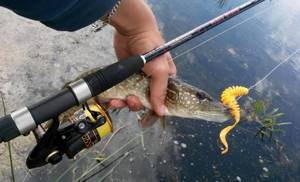
Braided cord
It is believed that it is more practical to equip a spinning rod with a braided cord, since improved control of the bait and the small diameter with relatively high breaking loads of the material provide more advantages compared to monofilament, making the tackle more versatile. In pike fishing, braid with a diameter of 0.12 to 0.18 mm is used.
Important! The color design of the cord has a negligible effect on the success of fishing; basically, this parameter is convenient because it allows the fisherman to better track the process of wiring.
Beginner spinners are recommended to use bright, contrasting thread colors.
Fluorocarbon line
Fluorocarbon fishing line has even more rigid characteristics than braided line, but has low breaking loads. These qualities exclude the prerequisites for using this kind of cord as a basis. Spinners use fluorocarbon to make shock leaders, thereby meeting the needs of fishing on shell rocks and pebble bottoms, where braided line is inferior in reliability and is subject to severe abrasion. This technique helps to achieve reliability of the equipment without reducing the degree of control over the action of the bait.
Gear that makes up a spinning rod
The basis of spinning tackle is the rod, which in turn consists of several elements:
- form;
- handles;
- reel seat;
- pass rings.
The next most important part is the coil. Depending on the fishing method and personal preferences of the fisherman, it can have different sizes and differ in design features.
Monofilament is wound onto the spool of the reel. The role of this element is played by monofilament or fluorocarbon fishing line, as well as braided cord. At the end of the main monofilament, various baits, weights and equipment are installed. They can be attached directly or with a carabiner.
Selecting a rod
When assembling a spinning rod, it is very important to choose the right rod that will be optimally suited for certain fishing conditions. Attention should be paid to the following parameters:
- material of manufacture;
- length;
- system;
- test;
- quality of fittings;
- knee connection design.
The cheapest spinning rods are made from fiberglass. Their main disadvantages are:
- heavy weight;
- low sensitivity;
- slow build.
The advantages include low cost and high strength characteristics. Even deliberately breaking such a product is not easy. Fishing with such a fishing rod is unlikely to bring pleasure and the desired result, since the fisherman’s hand will quickly get tired, and most bites will go unnoticed.
For modern fishing methods, spinning rods made of high-modulus graphite with a minimum amount of binding resins are much better suited. They differ:
- minimum weight;
- high sensory;
- good ergonomics.
Disadvantages include high cost and poor resistance to abrasive loads. Breakdowns of such fishing rods often occur during transportation when they come into contact with hard objects. They should be delivered to the fishing spot in a hard tube.
The length of the spinning rod largely determines the casting distance and ease of use. When fishing from the shore, it is better to use models with a length of 2.7–3 m, which will allow you to cast the bait as far as possible, which is often necessary.
Rods with a length of 1.9–2.1 m are excellent for fishing from a boat. Short “sticks” are much easier to manipulate in confined spaces. Special mention should be made of ultralight class rods, the length of which rarely exceeds 2 m. With such rods it is easier to control a light bait and give it a delicate game.
The structure of the rod determines the casting distance and affects the overall sensitivity of the tackle. All spinning rods are divided into 3 main formations:
- fast;
- average;
- slow.
Models with a fast action are characterized by increased rigidity of the blank and are well suited for jig fishing. Thanks to their high sensitivity, the angler has the opportunity to sense the lightest fish bites and determine the nature of the bottom topography.
“Sticks” with a medium action are more often used for fishing with oscillating spoons. They have good shock-absorbing properties, which makes it possible to:
- make long casts;
- use thinner monofilaments;
- easily handle large trophies.
Slow action rods are ideal for fishing with light baits that do not require animation when retrieving. A very important parameter is the rod test. This indicator determines how much bait weight needs to be loaded on the form so that it works as efficiently as possible. When choosing a spinning rod, you should pay attention to the quality of the materials from which the guide rings are made.
This is very important, since during the fishing process the internal parts of the element experience constant friction against the fishing line, which can result in the formation of cuts. The plug-in design of the knee connection is more preferable than the telescopic one, since it does not increase the weight of the product and minimally affects the strength characteristics of the gear.
Reel and its varieties
The reel is an integral part of the tackle, participating in all stages of fishing. There are 3 types of structures:
- inertialess;
- multiplier;
- classic inertial.
The inertia-free option is one of the most common. With the help of such models you can throw both heavy and light baits. Spinning rods are usually equipped with reels ranging in size from 1500 to 3500.
The additional number of bearings that influence the speed of rewinding the fishing line is usually 5:1. All information about the performance characteristics of the product is usually written on the spool. The model is selected correctly if, when assembled, the center of gravity of the tackle is located in the area of the reel seat.
Multiplier reels have direct draft, which makes them more powerful and reliable. In addition, they allow you to control the flight of the bait and eliminate sagging line, which facilitates accurate casting and increases the pace of fishing.
The disadvantages of such products include:
- high price;
- inability to use baits weighing less than 2 g;
- frequent tangling of the line among inexperienced anglers.
Using a “multi” will require the fisherman to have certain casting skills. When changing the weight of the bait, you will need to adjust the spool rotation. Classic inertia models are used in modern fishing extremely rarely, since in most parameters they are inferior to “inertia-free” and “multi” models.
Braided cord or fishing line
Both braided cord and monofilament or fluorocarbon fishing line can be wound onto the reel spool. Braid has a number of advantages:
- minimum diameter at high breaking load;
- almost zero elongation;
- lack of "memory".
The diameter of the monofilament is very important when fishing in currents. The thinner the cord, the less it is exposed to the pressure of the water flow, which helps to increase the sensitivity of the gear. High breaking load allows you to confidently fight large fish.
Zero stretch increases the sensitivity of the tackle and makes it possible to reliably cut through the bony mouth of a predator. The lack of “memory” in the cord contributes to the casting distance. The disadvantages of braided fabric include its low resistance to abrasive loads. It is damaged even upon slight contact with shells or stones, which leads to a sharp decrease in its strength. For spinning fishing, cords with a diameter of 0.08 to 0.16 mm are usually used.
Monofilament fishing line is usually used in still waters, when the bait is rotating or oscillating spoons that do not require additional animation. Such monofilament has a high elongation coefficient, which makes it impossible to use in jig fishing. Good shock-absorbing qualities are useful when fishing for large fish. In most cases, a “monofil” with a thickness of 0.20–0.25 mm is used.
Fluorocarbon fishing line is very wear-resistant, so it is advisable to use it when fishing on small rivers with rocky soil. When fishing with micro-jigs, this monofilament option will also be more effective. The diameter of the fluoric can vary from 0.1 to 0.16 mm.
What hooks should you have?
Lures are equipped with various types of fishing hooks. The most common ones include:
- tee;
- double;
- single;
- offset worker
Wobblers, topwaters and large oscillating spoons are usually equipped with tees. This type of hook provides the most reliable hooking, but at the same time, it seriously injures the fish. In addition, models of this design are more susceptible to snagging, which will inevitably lead to frequent loss of baits. Doubles are usually installed on jig baits. They detect predators well, but at the same time they cling to snags much less often than tees.
Single hook modifications are used when fishing with a drop-shot rig. Models without a barb are equipped with small trout spoons and mini-wobblers. An offset hook is used in combination with silicone baits and is indispensable when fishing in heavily snag areas of a reservoir. There are designs with a wire fender that allow you to fish in dense thickets.
What loads are best to use?
Jig baits are equipped with various types of weights, the modification of which directly depends on the type of equipment used. The most common ones include:
- classic jig head;
- "Cheburashka";
- "bullet";
- "Tyrolean" stick;
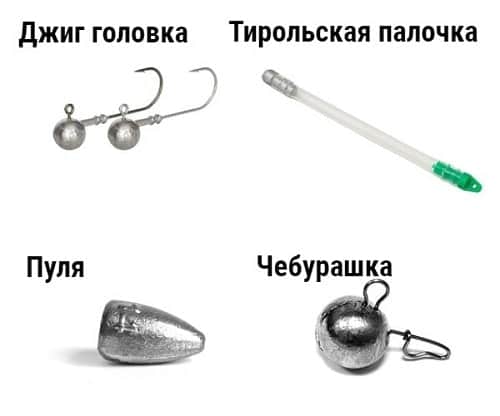
A classic jig head with a soldered hook is best used in still waters. Thanks to its design, it is less susceptible to snags and cuts through predators well.
The Cheburashka weight has proven itself to be excellent when fishing in currents. The articulated joint allows the bait to play more actively in the water flow, provoking the fish to bite. This design has excellent flight characteristics, which makes it possible to make long and accurate casts. A loading option called “bullet” passes perfectly through any snags. It is usually used in combination with Carolina rigs.
The “Tyrolean” stick is a plastic tube about 15 cm long, in the upper part of which there is a hole for attaching a fishing line, and in the lower part there is a weight. Using this design, you can fish in reservoirs with a rocky bottom. This type of load is used in the “diverter leash” equipment.
Requirements for leashes
The leash in spinning tackle plays an important role. It protects the main line from the teeth of a predator and prevents it from being damaged by stones and sharp edges of shells. This element is made from the following materials:
- Kevlar wire;
- thin tungsten filaments;
- guitar string;
- fluorocarbon line.
It is advisable to use leashes made of rigid Kevlar wire when fishing with jerkbaits and large minnow-class wobblers. These baits have practically no game of their own and are animated with sharp, sweeping jerks. The rigid leash design prevents hooks from catching on the main line.
Products woven from several tungsten threads have medium hardness and can be successfully used when fishing on oscillating and rotating spoons. They reliably protect monofilament from pike teeth and abrasive loads.
Guitar string leaders work great in combination with jig baits. They have several advantages over other designs:
- minimum cost;
- possibility of quick self-production;
- increased reliability.
There is a twist loop at both ends of the string that allows you to quickly change baits without using carabiners. Fluorocarbon monofilament is used when fishing is done with small wobblers.
The softness of such a leash ensures stable play, however, if a toothy pike bites, the loss of the bait can hardly be avoided. When fishing for small fish, a leash up to 10–15 cm long is quite suitable. If you plan to catch trophy pike, the length of this element of equipment should be at least 30 cm.
Swivel
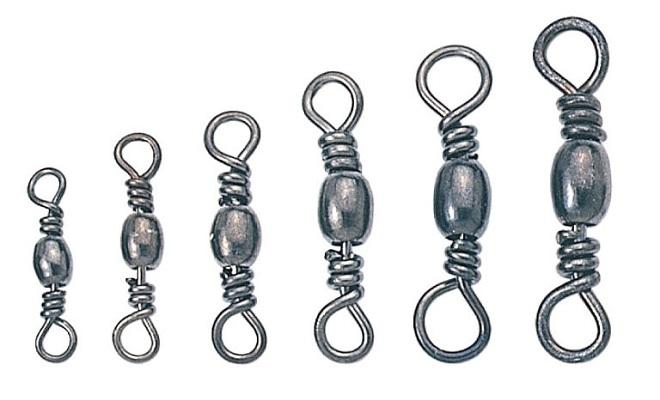
The swivel is one of the effective equipment elements that allows you to qualitatively equip a spinning rod for pike for fishing with rotating spoons. The use of spinners leads to twisting of the cord, which is especially noticeable when using braids. The introduction of a swivel directly onto the winding ring of the hunting accessory eliminates this trouble. When working with other baits, the swivel is not necessary for use; its role becomes useless, making installation only rougher.
How to tie to a fishing line?
For fixing spinners on monofilament fishing line, we can recommend the Grinner knot. This option has the following features:
- The bait has a degree of freedom, which allows it to open up as much as possible when retrieving.
- The strength at the knot does not actually decrease and corresponds to the breaking load of the straight section of the main line.
- Easy to learn, suitable for beginners.
- With some experience and the necessary skills, this option can be knitted within a few seconds.
“Grinner” is most optimal for elastic soft nylon fishing lines. It is not so good with fluorocarbon or rigid monofilaments. It is advisable to replace it with the Rapala knot shown below. The method under consideration is knitted in the following way: 1. The end of the nylon is threaded into the eye of the bait.
2. The thread is folded in half, the optimal length of the double line is up to 15–20 cm.
Advice! It is not necessary to attach the bait directly. A leash, swivel or fastener can be placed in front of the spinner.
3. We wrap the thread folded in half with the free end approximately five to seven times.
4. The free end of the monofilament is threaded into the resulting loop.
All that remains is to slowly tighten the thread, after wetting it. The excess end of the monofilament is cut off.
"Grinner" is a good choice for monofilament fishing line
Leash
A distinctive feature of pike fishing is the presence in the equipment of a metal leash that can withstand sharp pike teeth, which is not possible for the material of any main cord. When assembling a spinning rod for a large pike, pay attention not only to the material, but also to the length of the leash, using an element no shorter than 20 cm. Leashes are made of steel, tungsten and titanium. All these materials differ in their rigidity and also in price.
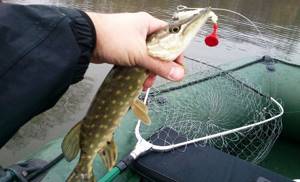
For example, steel leaders are rough but inexpensive. The tungsten leader is much softer, but it has a high price level. The use of a rough leash reduces the attractiveness of the equipment, making the play of baits cramped. The latest trends in pike fishing, which are striving for thinner rigs, have made it possible to use fluorocarbon and Kevlar as leader materials, which, of course, has had a positive effect on the increase in the number of bites. But only time-tested metal leashes provide high reliability against snacking.
Which leash to choose
If you plan to fish for predatory fish, you will need a leash. This is due to the fact that a predator can easily damage the main fishing line with its teeth. The leash comes in several types:
- Soft. Suitable for catching passive predators. It is durable and yet invisible to fish in the water.
- Semi-rigid. Suitable for pike fishing. It has unstable durability. If a predator touches it with its teeth, then such a leash will become deformed.
- Hard. It is used in equipment only when heavy bait is used to feed predatory fish. But it is worth remembering that it is clearly visible to the water. Therefore, it is not recommended to use such a high-rigidity steel leash during summer fishing, when predatory fish are passive. It is better to choose an inconspicuous installation.
Tackle for pike fishing with spinning rod and bait according to the seasons
Depending on the season of the year, the behavior of the predator changes, the degree of its feeding activity either increases or decreases. In connection with these features, the equipment of a spinning rod for pike fishing is undergoing changes, expressed in the adjustment of rigs to the bait used. So that a novice spinning angler can fine-tune his tackle in the right direction, we will consider the annual fishing cycle in the context of using the most promising baits for the season.
Spring
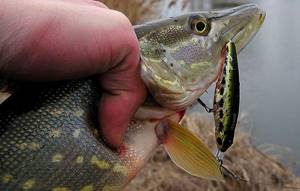
Spring time is characterized by a surge in the activity of pike in the pre-spawning period, a time of no-biting during the spawning itself, a post-spawning glutton and the transition of the fish to a sedentary lifestyle with insignificant feeding activity. Spring is characterized by the use of small-sized baits with intense play in fishing. Crank-type wobblers and spinners fit these definitions. The distinctness of the play of these instruments provides the prerequisites for the use of nylon cords in equipment.
Summer
In the summer, the toothy one becomes capricious. The abundance of natural food available to the fish forces the fisherman to look for bait that most closely imitates the behavior of the fry. The rod's fast action coupled with thin braided line allows for the highly controlled animation required for minnows and topwater poppers. The use of this type of simulators in the summer season is a priority.
Autumn
The protracted period of the predator's autumn feeding period makes it possible to reduce the requirements for the quality of animation of baits. To increase the reliability of the equipment, you can use a medium-action rod without increasing the diameter of the braided cords. The sizes of baits are increased in the hope of catching large specimens of the trophy. Pike fishing gear in the fall may be coarser compared to equipment at other times. In the autumn, silicone baits, spinners and wobblers of various types are used.
Fishing line and braided cord
For a long time, fishermen have been arguing about what is better to equip their spinning rod with: braided cord or monofilament, the most common fishing line. In such a dispute, everyone has their own truth. You need to choose based on the type of fishing and the characteristics of the place chosen for fishing.
Standard monofilament is less durable than cord. It is approximately two times less durable. It should also be noted that it tends to stretch in water. This can be considered its disadvantage and disadvantage at the same time. Thanks to this feature, during fishing the load on the fishing rod becomes less and landing small fish is an easier process. But the downside is that there is no bite transmission speed. As a result, the fisherman reacts more slowly to a bite. It is also worth taking into account that a spinning rod with such a fishing line will have difficulties with the animation of some types of baits.
Rigging using braided cord will have a higher strength rating. It is practically not subject to deformation under the influence of water. The cost of such a cord is higher than that of a regular fishing line, but it will last much longer. If you use it frequently during the fishing season, it will be unsuitable for use the next. equipment during intensive use in fishing is one season. But it is important to remember that using a braided cord can damage the blank rings.
When equipping spinning rods with such a cord, it is recommended to use it in the following cases:
- Fishing with long casts;
- Use of silicone baits in fishing;
- Catching trophy fish.
How to properly equip a spinning rod for pike
In continuation of the article, we will present to the novice spinning angler a detailed algorithm of actions for simple and easy assembly of the fishing rod. Following these simple recommendations, the assembled tackle will be a comfortable and reliable tool in the process of pike hunting.
Attaching the reel to the spinning rod
The reel is attached and mounted to the butt of the rod through special threaded clamps.
Important! The inertia-free fastening bracket must fit tightly, but without tension, into the fastening grooves. Also, when seating the fastening leg, no play is allowed.
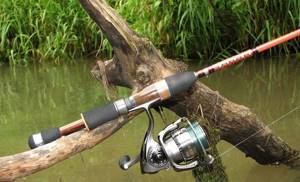
After installing the bracket into the grooves, the clamping is carried out using a worm gear until the fastening element of the butt rests on the leg of the mechanism.
Winding line
Having secured the reel, proceed to winding the selected cord. The tip of the cord is pulled into the winding rings of the rod, starting with the smallest one, located on the quiver tip of the tackle. Having folded the line guide of the spool, the cord is tied to its base. Next, having created tension on the cord, they begin winding, turning the reel at medium speed. The tension allows you to lay the line evenly and without overlaps, which in turn has a positive effect on the unhindered flow of the line and the casting distance of the bait. Thread tension can be created by passing the cord through the pages of a thick book.
Important! After winding the fishing line, there should not be a gap of more than 2 mm to the edge of the spool.
If the thickness of the cord is not enough to ensure this condition, backing is placed on the spool, a material that reduces the presence of free volume.
Connection of fishing line and leash
It is recommended to connect these equipment elements using straight knitting. Since the required leash length is selected immediately before fishing, replacing this accessory during fishing is not required. Carabiners and fasteners will ultimately reduce the delicacy of the equipment, without bringing any practical benefit for the convenience of working with the equipment.
The easiest and most reliable way to connect the leash to the main cord is with uni, clinch or polomar knots. Soft fluorocarbon leaders are connected using the loop-to-loop method.
Mounting the bait
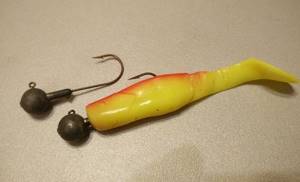
The baits are connected through additional fasteners. This principle allows you not to waste time on the required frequent changes of bait when choosing the most suitable option for fishing conditions. Silicone is placed on hooks with stationary jig heads or hinged weights with fastening loops, through which the baits are connected to the cord fastener. Spoons and wobblers can be attached using winding rings. This operation, although much more complicated than fastening with a fastener, has a lesser effect on the play of baits and the delicacy of the tackle, which is not so important when fastening a jig bait, the animation of which directly depends on the actions of the spinning player himself.
What knots to tie a wobbler to braided cords
It is preferable to attach these types of artificial baits to the braided line using the following types of knots:
- double clinch;
- Rapala manufacturer's assembly;
- palomar.
These types of knots, with the peculiarities of their knitting, most closely match the physical properties of the fence. As you know, braid is rougher in relation to the qualities of monofilament and fluorocarbon and is able to withstand, without any harm, such a knitting, without fear of creases, overtightening and burnout. The use of these units is used directly in the installation of bait directly, through a leash and using winding rings.
Types of spinning equipment
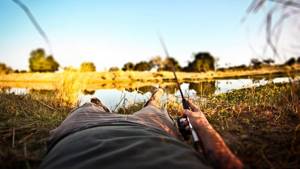
For each of the baits used in spinning fishing, different types of equipment are used, including the length, action and test of the rod, the type and thickness of the fishing line, the presence, material and length of the leash.
How to equip a spinning rod with a wobbler?
- rod - fast or ultra-fast action, 180-210 cm long with a test weight from 15 to 20-25 g;
- fishing line - braided cord with a cross-section of up to 0.18-0.20 mm;
- leash – thin tungsten, up to 15-20 cm long.
How to equip a spinning rod with a spinner?
- rod – fast or medium action, length 240-270 cm with a test weight from 15 to 30-40 g;.
- fishing line - monofilament fishing line with a cross-section of up to 0.3-0.35 mm or braided cord with a cross-section of up to 0.20 mm;
- leash – thin tungsten or metal, up to 15-20 cm long.
How to equip a spinning rod with a feeder?
- rod - fast action, length from 330 (for lakes and ponds) to 390-420 cm (for rivers) with a test from 60-90 (for standing water) to 120-150 g. (when fishing in the current);
- fishing line - braided cord with a cross-section of up to 0.20-0.25 mm for the main fishing line, monofilament with a cross-section of 0.25-0.3 mm for the shock leader;
- feeder - rectangular metal weighing from 40 to 100-120 g;
- leash – a piece of monofilament fishing line with a cross-section of up to 0.18 mm and a length of up to 50 cm with hook No. 10-8.
Jig rigs for spinning
Silicone jig baits are connected to a line and sinker using several common rigs:
- the bait is put on a solid jig head with a hook;
- The bait is put on a simple or offset hook to which a collapsible Cheburashka sinker is hingedly attached.
Also, jig baits are used for such installations as:
- Texas rig - a twister or vibrohook mounted on an offset hook is tied to a leash made of monofilament fishing line up to 100 cm long. At the point where the leash and the main line are attached, a sliding bullet weight is installed, the movement of which towards the leash is limited by a stopper bead;
- Carolina rig - unlike the previous one, in this rig the bullet-shaped sliding sinker is placed directly on the leash with the bait;
- branch leash - a piece of monofilament about 30 cm long with a drop-shaped sinker weighing up to 14-16 grams is tied to one of the branches of the triple swivel. at the end, a leash made of the same monofilament up to 120 cm long is tied to the perpendicular branch; at the end there is a hook with a silicone bait attached to it. The main line is tied to the last branch.
What does spinning tackle consist of?
The main elements of spinning tackle are:
- rod;
- inertia-free or multiplier reel;
- fishing line or braided cord;
- leash;
- bait;
Let's celebrate! Each of these elements has its own functions and plays a big role in the reliability and functionality of the gear as a whole.
Characteristics of a spinning rod
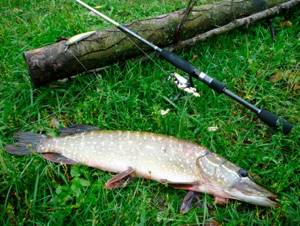
A spinning rod is a composite whip (blank), on which it is located with a handle with a locking device for the reel and a row of guide rings evenly spaced in the working part
Good to know! Among the main characteristics of modern fishing rods, the main ones are length, action, test, blank material, handle design.
Length
According to this characteristic, all spinning rods are divided into:
- short – up to 210 cm;
- medium – 240-270 cm;
- long – over 300 cm.
Let's celebrate! Short spinning rods are used from a boat, as well as for shore fishing in small bodies of water; medium - for rivers and lakes of significant size; long - for fishing on large and deep rivers, large reservoirs and lakes.
Build
The action represents the reaction of the spinning rod's whip to the resulting load. The reaction is understood as the degree of its bending in parts relative to the entire length of the form from tip to handle:
- fast - only the upper 1/3 of the form reacts to the load;
- medium – the form is bent to half;
- slow - under load, almost the entire (3/4) part of the whip is subject to bending.
Test
This characteristic represents the range of weights recommended by the manufacturer for the baits used with a particular rod.
According to the test or casting, all spinning rods are divided into 5 classes:
- ultra-light - 1-7 g;
- light – 8-15 g;
- medium – 15-30 g;
- heavy – 30-40 g;
- super heavy – over 40 g..
Form manufacturing material
Modern spinning rod blanks are made from materials such as:
- Carbon fiber is a modern lightweight and durable material that allows you to obtain reliable, lightweight and flexible fishing rods. The disadvantage of graphite blanks is their vulnerability when dropped onto a hard surface (concrete floor, slabs) as well as from pinpoint impacts on stones, faces and edges of hard objects.
- composite is a material that is a mixture of carbon fiber and fiberglass. Thanks to this composition, such fishing rods are not as delicate as graphite ones, they have a fairly affordable price, but at the same time they lose to the latter in weight and strength.
- fiberglass is a rigid and heavy material that makes it possible to obtain the most durable, but at the same time not flexible or sensitive rods of sufficiently large weight.
Handle design
The handle in modern fishing rods can be of two types:
- solid – having a constant diameter along the entire length;
- spaced – has breaks in the handle structure, designed to reduce the weight of the rod.
Also, according to the length of the handle, all spinning rods are divided into:
- one-handed;
- two-handed.
Choosing a spinning reel

In modern spinning gear, two main types of reels are used:
- inertialess;
- cartoon.
Good to know! Since the latter, due to their cost, are used much less frequently, the choice of this element of gear will be considered using the example of an inertia-free reel.
When choosing a coil, the following characteristics are taken into account:
- size;
- weight;
- the number of bearings in the mechanisms of line laying, rotation of the spool and handle;
- gear ratio.
The size indicates how much line the spool of a given reel can hold. According to the classifications of various manufacturers, there is a gradation of reel sizes from 500-1000 to 8000-12,000. Size 2000 can be deciphered as follows: the capacity of the reel spool is 100 meters of fishing line with a cross-section of 0.2 mm. Accordingly, the thicker the fishing line they plan to use, the larger the size of the reel they choose.
The weight of the reel plays a huge role in the ease of use of the tackle and its balance. When choosing a reel, it must be attached to the spinning rod with which you plan to use it. The use of both heavy reels with light spinning rods and light reels with heavy blanks will lead to the fact that the tackle will be unbalanced, and this will affect casting, retrieving, hooking and fishing
Let's celebrate! The number of bearings for spinning spinning reels should be at least 3 - this will ensure smooth movement of the handle when rotating, normal rotation of the spool, and uniform winding of the fishing line on it. The number of bearings is indicated on reels in the context of mechanisms such as the spool and handle - for example, “9+1” means 1 bearing in the handle rotation mechanism, 9 - in the spool.
The gear ratio, indicating how many revolutions the spool makes per revolution of the handle, for a spinning reel must be at least 5.
fishing line
Summer and winter spinning equipment are significantly different; when choosing it, you need to pay attention to the correct selection of fishing line.
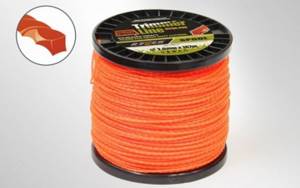
A good braided fishing line is characterized by increased strength and wear resistance, capable of withstanding long-term and intensive use and maintaining its integrity.
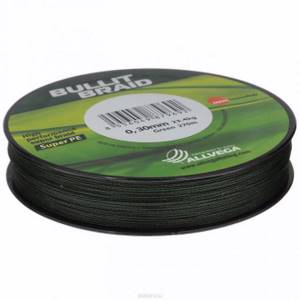
Braided fishing line is available in different variations with sliding effects, and differs in thickness and color, such parameters are selected for the body of water and the fish.
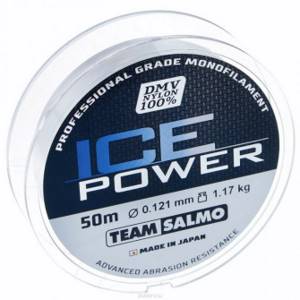
Under increased loads and frequent casting of a fairly heavy bait, the braided fishing line does not stretch and twists into loops, which makes fishing easier.
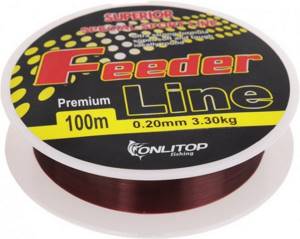
Note!
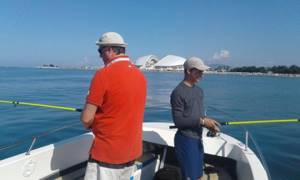
Fishing with a nipple - installation of gear, bait, tips and tricks from the pros! (120 photos + video)- Jig equipment - assembly and installation of equipment. Types of equipment and tips for use for beginners (90 photos)
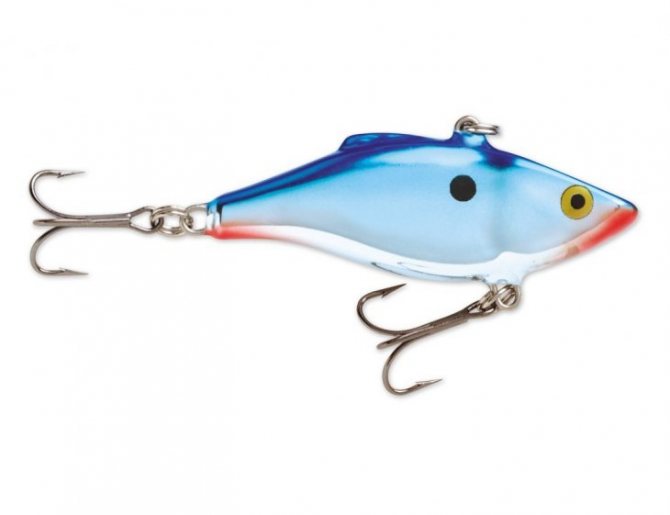
Types of wobblers - tips and secrets of fishing with bait for beginners. Fishing techniques and methods of catching fish (110 photos and videos)
Choosing the right bait to prepare for fishing. Knowing all types of spinning equipment and the peculiarities of fishing for different types of predators, it is easy to select artificial baits:
- spinners for winter trolling that imitate small fish;
- wobblers, which are solid baits;
- mice for fishing large predatory fish in large bodies of water;
- spinnerbait, combining the characteristics of a spinner and a fly;
- vibration tails made of silicone materials, characterized by a flat tail;
- plastic and silicone twisters imitating worms and insects.
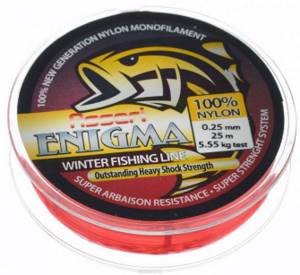
In order to choose the right artificial baits, you need to know the behavioral characteristics of predatory fish, their feeding places and feeding habits.

